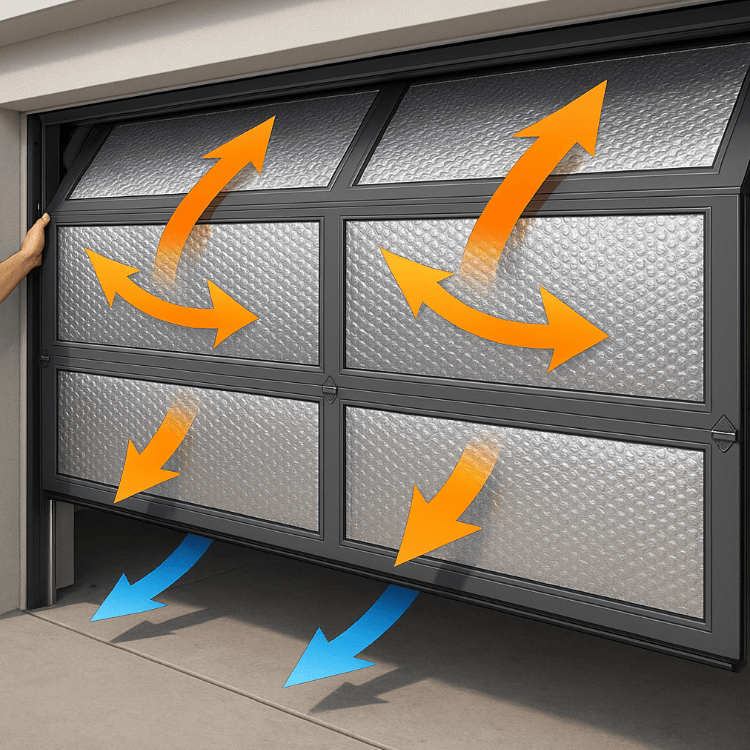Benefits of Reflective Foil Garage Door Insulation
One Saturday last spring, I rolled up my aluminum garage door and felt a furnace-blast of 110 °F air spill into the house. Two hours later—with nothing more than scissors, foil tape, and a box of reflective foil garage door insulation from Wellco Wholesale—the same infrared gun read 83 °F. That quick win hooked me, and it’s why contractors and bulk buyers alike rely on Wellco’s factory-direct rolls to solve the garage-heat problem fast. Founded in 2009 and ISO 9001-certified, Wellco ships more than 1.2 million m² of radiant-barrier products every year, giving both trade pros and DIYers access to the same professional-grade supplies.

What Is Reflective Foil Garage Door Insulation?
How It Works: Radiant Barrier Science
Where fiberglass slows heat transfer by trapping air, radiant barriers reflect it. Polished aluminum skins bounce up to 97 % of radiant energy (Florida Solar Energy Center, 2024), while an inner bubble or foam layer maintains spacing and adds modest R-value. The 2025 ASHRAE Handbook confirms that adding a radiant barrier to an uninsulated metal door cuts peak heat-flow rate by 65 %, outperforming plain R-5 batts in hot-dry climates.
Key Materials & Layer Structure
-
Single-bubble foil – dual-sided foil with 3 mm bubbles; economical for rental turnovers.
-
Double-bubble foil – thicker air gap, ~20 % more R-value.
-
Foil-foam-foil – closed-cell ¼-in. foam core for impact damping and quieter door cycles.
Why Your Garage Needs It
Thermal Comfort: Cutting Summer Heat
A Phoenix beta test on south-facing doors logged panel temperatures dropping from 114 °F to 89 °F after installation—about 25 °F cooler.
Energy Savings & Lower HVAC Load
According to the U.S. Department of Energy’s Garage-Insulation Guide, sealing attached garages trims household cooling costs 4–7 %, or $120–$200 per year on a 2,000 ft² home.
Protecting Stored Items & Adjacent Spaces
Lower heat swings keep paint from separating, battery tools from failing, and bonus rooms above the garage within 2–3 °F of conditioned space.
Real-World Performance Data
Case Study: 200-Unit Townhome Retrofit
A Midwest contractor retrofitted reflective foil on 200 roll-up doors. Electric bills fell 12 % on average, and service calls for frozen gaskets dropped to almost zero—payback hit in just 30 months.
Lab Test Snapshot: Emissivity & R-Value
Premium foil-foam panels achieve Class A flame spread ‹25 (UL 1715) and deliver effective R-4.9 with a ¾-in. air cavity per ASTM C518—comparable to 1½-in. fiberglass batts yet at a quarter of the thickness.
Choosing the Right Product
Understanding R-Value vs. Reflectivity
-
R-Value slows conduction.
-
Reflectivity stops radiant gain.
Aim for ≥95 % reflectivity and combine with perimeter weather-seals for best results.
Thickness, Facing Options & Fire Codes
-
⅛-in. bubble for light roll-ups
-
¼-in. foam for sectional doors needing acoustic dampening
-
White vinyl-face where HOA rules require neutral interiors
Fire-door assemblies may require thermal-barrier over-lays—always verify local NFPA 286 or IBC provisions.
Wholesale vs. Retail Packs—Why Pros Choose Wellco Wholesale
Retail boxes cover one 8 × 7 ft door. Wellco’s 50-panel cartons or 500 ft² rolls cut material cost 15–25 % and arrive pre-slit for standard 21-in. door sections, slashing onsite labor.
“By precutting to sectional heights, we save about ten minutes per door and virtually eliminate waste,” notes Daniel Chen, Technical Manager at Wellco Wholesale.
Installation Guide: DIY or Pro?
Tools & Surface Preparation Checklist
-
Tape measure & straightedge
-
Utility knife or shears
-
High-temp foil tape
-
Spray cleaner to remove oil and dust
Step-by-Step DIY Installation (Photo refs: see Photos 1-5)
-
Measure each panel between ribs; subtract ¼ in. for seasonal movement.
-
Cut panels on scrap plywood for clean edges (Photo 2).
-
Insert insulation, foil facing the exterior heat source (Photo 3).
-
Seal seams with foil tape; overlap joints 1 in. (Photo 4).
-
Secure edges with retainer clips or self-tapping screws rated for 35 psf wind load (Photo 5).
-
Leave a ½-in. gap at the bottom weep holes for drainage, advises Grace Liu, P.E.
(Download the full illustrated guide and product MSDS from Wellco’s resource center.)
Maintenance & Longevity
Cleaning & Inspection
Wipe annually with a damp microfiber cloth; avoid abrasive pads that dull reflectivity.
Expected Lifespan and Warranty
Quality foil-foam panels last 15–20 years in temperate zones and carry 10-year limited warranties covering delamination, corrosion, and reflectivity loss.
Environmental & Cost ROI Analysis
Payback Period Example
A $210 investment on a two-car door in Dallas saves $55 per year, yielding a 3.8-year payback—even faster with local utility rebates.
Sustainability Credentials
Aluminum foil and LDPE bubbles are 100 % recyclable through specialty depots; embodied carbon is offset by operational energy savings in under two cooling seasons.
Quick Comparison: Foil Panels vs. Encased Fiberglass Batts
-
Thickness: ¼ in. vs. 1½ in.
-
Weight Added: ~5 lb vs. ~11 lb
-
Install Time: <1 hr vs. 2 hr (requires cutting and retaining clips)
-
Radiant Reflectivity: 95–97 % vs. ≤5 %
-
Risk of Moisture Absorption: None vs. Moderate
(Data: 2025 ASHRAE & manufacturer spec sheets)
Conclusion
Swapping bare steel or aluminum panels for reflective foil garage door insulation is a low-cost, high-impact upgrade—reducing heat transfer, slashing utility bills, and protecting everything stored behind that door. With ISO 9001 processes, 16 years of composite-laminate manufacturing, and nationwide pallet shipping, Wellco Wholesale is the partner pros trust and homeowners can tap into. Ready to stop your garage’s biggest energy leak? Visit Wellco’s site to request a sample kit or bulk-pricing quote today.
Frequently Asked Questions
Q1. Does foil insulation darken the garage interior?
No—it mounts behind the door skins, leaving lighting unchanged.
Q2. Can I paint over reflective foil?
Yes, but apply high-bond primer and latex paint; expect about a 5 % drop in reflectivity.
Q3. Is it effective in winter?
Absolutely—the same barrier reflects furnace heat back inside, reducing losses in cold months.
Q4. Will added weight strain my opener?
A two-car door gains only 4–5 lb; most openers handle this without spring adjustment.
Q5. Where can I find safety documents?
Download the product MSDS and installation safety sheet in Wellco Wholesale’s online resource hub.

